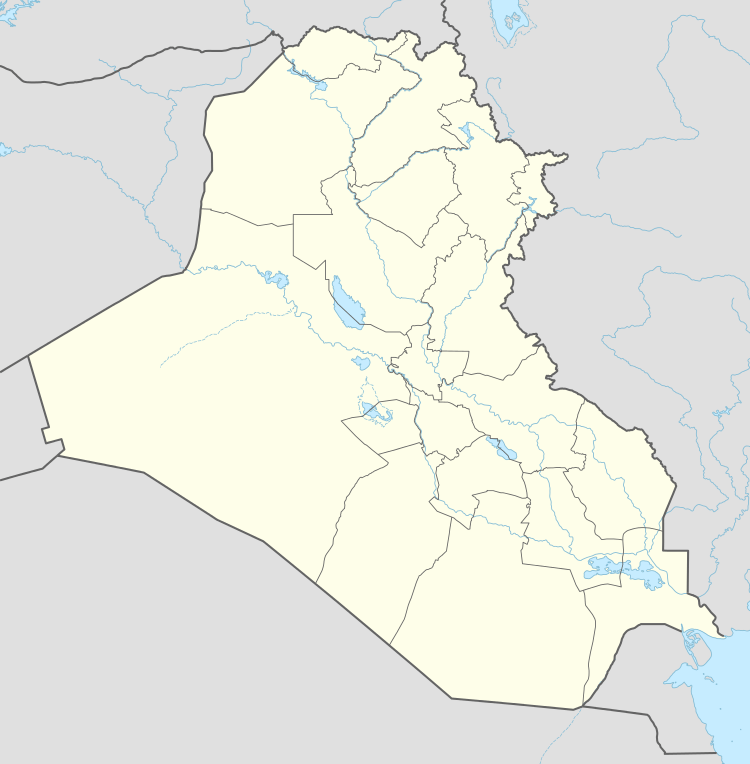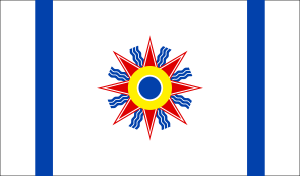Tel Keppe
Tel Keppe (also spelled Tel Kaif) (Syriac: ܬܸܠ ܟܹܐܦܹܐ Tel Kepe, Arabic: تل كيف Tall Kayf), is an Assyrian[2][3] town in northern Iraq. Its name means "Hill of Stones" in Syriac. It is located in the Nineveh Governorate, less than 8 miles north east of Mosul.[4] The town is a historic farming town consisting of a densely populated core, surrounded by farm land outside the city.
Tel Keppe ܬܸܠ ܟܹܐܦܹ̈ܐ | |
|---|---|
 Tel Keppe | |
| Coordinates: 36°29′22″N 43°7′9″E | |
| Country | Iraq |
| Governorate | Nineveh |
| District | Tel Kaif District |
| Government | |
| • Mayor | Basim Bello |
| Population (2010)[1] | |
| • Total | 40,000 |
| Prior to ISIS, August 2014 | |
| Demonym(s) | Tel-Kepniyah (m) / Tel-Kepnetha (f) |
History
The first reliable reference to the town is in 1403.[5]
In 1508, Tel Keppe was sacked by Mongols.
In 1743, Tel Keppe was looted and burned by the armies of the Persian leader Nader Shah. This event took place within the context of the Siege of Mosul, in which the Persian army suffered heavy casualties and resorted to looting the surrounding towns to have some semblance of victory.
In 1833, the town was once again sacked, this time by the Kurdish Governor of Rawandiz. He also sacked the nearby town of Alqosh.[4]
Occupation by ISIL
On 6 August 2014, the town was taken over by the Islamic State of Iraq and the Levant (ISIL), along with nearby Assyrian towns Bakhdida, Bartella and Karamlish.[6] Upon entering the town, ISIS looted the homes, and removed the crosses and other religious objects from the churches. The Christian cemetery in the town was also later destroyed.[7]
Soon after the beginning of the Battle of Mosul Iraqi troops advanced on Tel Keppe, but the fighting continued into 2017.[8][9] Iraqi forces recaptured the town from ISIL on the 19th of January 2017.[10] By 2018 a few of the Christian residents have returned and rebuilt their churches.
Climate
Tel Keppe has a semi-arid climate (BSh) with extremely hot summers and cool, damp winters, typical to the Nineveh Plains.
| Climate data for Tel Keppe | |||||||||||||
|---|---|---|---|---|---|---|---|---|---|---|---|---|---|
| Month | Jan | Feb | Mar | Apr | May | Jun | Jul | Aug | Sep | Oct | Nov | Dec | Year |
| Average high °C (°F) | 12 (54) |
14 (57) |
20 (68) |
26 (79) |
34 (93) |
38 (100) |
43 (109) |
40 (104) |
38 (100) |
30 (86) |
20 (68) |
14 (57) |
27 (81) |
| Average low °C (°F) | 2 (36) |
4 (39) |
8 (46) |
11 (52) |
16 (61) |
21 (70) |
25 (77) |
24 (75) |
20 (68) |
14 (57) |
6 (43) |
4 (39) |
13 (55) |
| Average precipitation mm (inches) | 39 (1.5) |
69 (2.7) |
51 (2.0) |
9 (0.4) |
0 (0) |
0 (0) |
0 (0) |
0 (0) |
0 (0) |
6 (0.2) |
36 (1.4) |
60 (2.4) |
270 (10.6) |
| Average precipitation days | 10 | 10 | 11 | 9 | 0 | 0 | 0 | 0 | 0 | 5 | 8 | 12 | 65 |
| Source: World Weather Online (2000–2012)[11] | |||||||||||||
Demographics
In 1768, the town had a recorded population of 2500. Due to plague and other disasters, the population was around 1,500 in 1882, rising to 2,500 again by 1891. In 1923, the population was recorded as 14,000. In 1933, the population numbered around 10,000. As a result of emigration from the town to Baghdad and the United States, the population shrunk to 7,108 by 1968.
The district of Tel Keppe was approximately 50% Christian in the mid 1900s, the town of Tel Keppe remaining almost exclusively Christian with a population of 6,600 inhabitants.[12] Throughout the late 20th century, the town experienced non-native population growth from the arrival of Sunni Arabs, who established residence outside the historic city core. By the turn of the century, the population had swelled to close to 30,000.[13]
Some families who settled in Tel-Keppe are:
- Asmar and Abso from Diyar Bakir
- Karmo and Mengeshnayeh from Saart
- Dinha/Joja, Shalal, and Abro from Ashita (Tiyari)
- Ma’arouf and Qoryaqos from Tella’far
- Zooma, Khoshe, and Hnawa from Mardin
- Jolagh from Alqosh
- Nasfo from Aleppo
- Saba and Kharkhar from Iran
- Twaini from Amadiya
- Orou from Sanna, Iran
- Jammo, Kassab, and Manni from Bashbetha
- Jibaya and Kthawe from Turkey
- Talya from Lebanon
- Qasha Giwargis from Quchanis, Turkey
- Qarbo from Jazirat Ibn Omar
- Bizzi from al-Karaj
- Qashat from Sinjar[14]
Tel Kepnayeh today
Starting in the 1980s and especially after the 1991 Gulf War and 2003 Invasion of Iraq, many Chaldean Catholic Assyrians from Tel Keppe fled to many countries, but primarily the United States. They set up their lives there with new churches and business for their families.[4] By 2001 many from Tel Keppe had moved to major cities in Iraq such as Baghdad or Mosul.[15]
In the United States
Many of the Chaldean Catholic Assyrians in the Detroit metropolitan area trace their origins to Tel Keppe. According to the estimates of a priest of Tel Keppe's Sacred Heart Chaldean Rite Catholic Church, there were 10,000 worshippers in the late 1950s and this decreased to 2,000 around 2004. He said that "Many people don’t want to go from here; they cry that they have to go… But you almost have to leave these days because your family probably already is in Detroit."[16]
San Diego, CA is the second most populated area of Chaldean Catholic Assyrians from Iraq, typically Tel Keppe. The community was largely led by Fr. Michael Bazzi and built through his pastoral duties. As the generations grow, Detroit and San Diego have accumulated more Chaldean Catholic Assyrians than the native land of Iraq.
Culture
Tel Keppe historically was the center of the Chaldean Catholic community of Iraq. Each family residing in Tel Keppe had one or more plots of farming land located outside Tel Keppe. The land produced barley and wheat, and animals raised there included goats and sheep. Natalie Jill Smith, author of "Ethnicity, Reciprocity, Reputation and Punishment: An Ethnoexperimental Study of Cooperation among the Chaldeans and Hmong of Detroit (Michigan)", wrote that in the reports of the village "everyone was related" and that marriage tended to occur between two people from the same village.[13]
Notable Tel-Kepniyeh
Deceased
- Maria Theresa Asmar, author and explorer, born in 1806. Published her memoir "Babylonian Princess" in English in 1844.
- Tariq Aziz, born Mikhail Yuhanna (1936–2015 ) Foreign Minister and Deputy Prime Minister and a close advisor of President Saddam Hussein. He studied English at Baghdad University and later worked as a journalist, before joining the Ba'ath Party in 1957.
- Emmanuel III Delly: Patriarch of Babylon of the Chaldeans. (1927–2014)
- Yusuf Malek, one of the leaders of the Assyrian movement in Iraq during the 1930s. Author of "The British Betrayal of the Assyrians".[17]
- Chaldean Patriarch Joseph II Marouf (1667–1713).
Living
- Mar Ramzi Garmou: Archbishop of Tehran – Iran for the Chaldean Chaldean Church.
- Mar Ibrahim Namo Ibrahim: Bishop Emeritus of the Chaldean Catholic Church for the Eastern United States.
- Mar Sarhad Yawsip Jammo: Bishop Emeritus of the Chaldean Catholic Church for Western United States.
- Mar Francis Y. Kalabat Bishop of the Chaldean Church for the Eastern United States.
See also
- Nineveh Plains
- Proposals for Assyrian autonomy in Iraq
- Assyrian homeland
- Batnaya and Barwari – Assyrian tribes also in Northern Iraq
References
- هل كانت تلكيف بلدة آشورية قديمة؟, فؤاد يوسف قزانجي
- Sonawane, Vishakha (February 10, 2017). "Christian War On Muslims? Iraqi Christian Militia Leader Threatens Sunni Arabs, Asks Them To Leave Assyrian Town". International Business Times. Retrieved August 4, 2020.
A leader of a Christian militia in the Shiite-majority nation of Iraq threatened to “dispose of” Sunni Arab tribes in the northern Assyrian town of Tel Keppe if they did not vacate the area by Friday, according to Middle East Monitor (MEMO).
- "Iraqi forces regain control of two more neighborhoods in east Mosul". ParsToday. January 22, 2017. Retrieved August 4, 2020.
Members of the 9th Armored Division in the Iraqi Army retook the road linking Bahwiza neighborhood in northern Mosul to the Assyrian town of Tel Keppe
- Welcome to Tel Keppe at ChaldeansOnline http://www.chaldeansonline.org/telkeppe/
- Wilmhurst, David (2000). The Ecclesiastical Organization of the Church of the East, 1318-1913. p. 205.
- Barack Obama Approves Airstrikes on Iraq, Airdrops Aid
- "Aiding the Assyrians Fight Against ISIS". The Huffington Post. 2015-04-15. Retrieved 2016-05-02.
- Alkhshali, Hamdi; Smith-Spark, Laura; Lister, Tim (22 October 2016). "ISIS kills hundreds in Mosul area, source says". CNN. Retrieved 22 October 2016.
- "Iraqi residents flee Islamic State-held town of Tel Keyf". YouTube. Reuters. 10 January 2017. Retrieved 12 January 2017.
- Griffis, Margaret (19 January 2017). "Militants Execute Civilians in Mosul; 101 Killed Across Iraq". Antiwar.com. Retrieved 20 January 2017.
- "Tel Kaif, Ninawa Monthly Climate Average, Iraq". World Weather Online. Retrieved 22 January 2017.
- Khadduri, Majid (1956). Area Handbook on Iraq – Volume 58 of Human Relations Area Files. Johns Hopkins University. p. 76. Retrieved 21 October 2016.
- Smith, Natalie Jill. "Ethnicity, Reciprocity, Reputation and Punishment: An Ethnoexperimental Study of Cooperation among the Chaldeans and Hmong of Detroit (Michigan)" (PhD dissertation). University of California, Los Angeles, 2001. p. 61. UMI Number: 3024065.
- Aprim, Fred (19 August 2004). "The Town of Tel-Kepe". Atour.
- Smith, Natalie Jill. "Ethnicity, Reciprocity, Reputation and Punishment: An Ethnoexperimental Study of Cooperation among the Chaldeans and Hmong of Detroit (Michigan)" (PhD dissertation). University of California, Los Angeles, 2001. p. 62. UMI Number: 3024065.
- "Arab, Chaldean, and Middle Eastern Children and Families in the Tri-County Area." (Archive) From a Child's Perspective: Detroit Metropolitan Census 2000 Fact Sheets Series. Wayne State University. Volume 4, Issue 2, February 2004. p. 2/32. Retrieved on November 8, 2013. "Archived copy" (PDF). Archived from the original (PDF) on December 26, 2010. Retrieved 2013-11-09.CS1 maint: archived copy as title (link)
- http://www.aina.org/books/bbota.pdf



